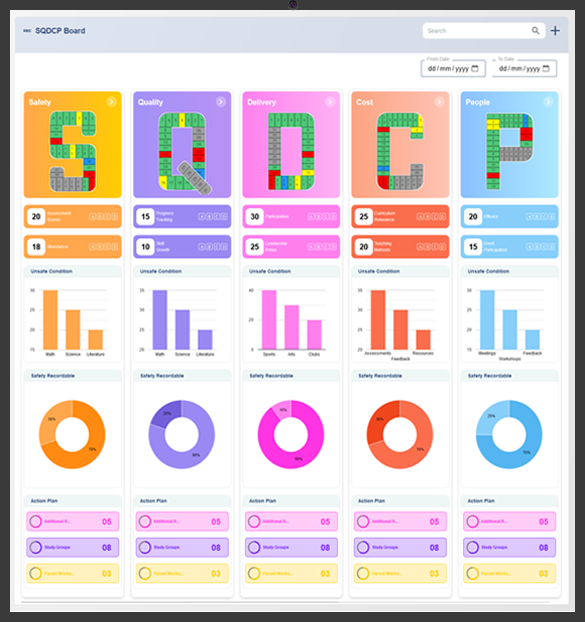Effective annual strategic planning requires a structured framework that aligns organizational goals with measurable outcomes. Balanced Scorecard (BSC) software enhances this process by providing a digital platform for monitoring performance, improving decision-making, and ensuring strategy execution. By leveraging this software, organizations can streamline their planning processes and drive long-term success.

1. Understanding Balanced Scorecard Software
Balanced Scorecard software is a digital tool designed to facilitate strategy management by integrating performance metrics, data visualization, and reporting functionalities. It allows organizations to track key performance indicators (KPIs) across multiple perspectives, ensuring a balanced approach to goal achievement.
2. Key Features of Balanced Scorecard Software
- Strategic Alignment: Ensures organizational activities are aligned with overarching strategic objectives.
- Data-Driven Insights: Provides real-time analytics and reporting for informed decision-making.
- Performance Monitoring: Tracks progress against defined KPIs and objectives.
- Goal Setting and Cascading: Allows goal distribution across different departments for seamless execution.
- Automated Reporting: Generates performance reports to evaluate progress and improvement areas.
- Customizable Dashboards: Enables organizations to tailor views based on priority metrics.
- Collaboration and Integration: Facilitates cross-functional teamwork and integrates with existing business tools.
3. How to Implement Balanced Scorecard Software for Strategic Planning
Step 1: Define Strategic Goals
Start by identifying key strategic goals that align with the organization’s vision. Clearly define objectives across financial, customer, internal process, and learning perspectives.
Step 2: Establish Key Performance Indicators (KPIs)
Select relevant KPIs to measure progress effectively. These indicators should be specific, measurable, attainable, relevant, and time-bound (SMART).
Step 3: Configure the Balanced Scorecard Software
Customize the software to reflect strategic goals and performance metrics. Define categories, data sources, and tracking parameters for streamlined monitoring.
Step 4: Assign Responsibilities and Roles
Allocate responsibilities to key stakeholders and team members. Ensure each department has clear accountability for their strategic contributions.
Step 5: Track Performance and Analyze Data
Use real-time dashboards to monitor KPI performance. Regularly review data insights to identify trends, gaps, and areas for improvement.
Step 6: Adjust Strategies Based on Insights
Refine strategic plans based on performance data. Adjust objectives and resource allocation as needed to enhance effectiveness.
4. Benefits of Using Balanced Scorecard Software for Annual Planning
- Enhanced Strategic Focus: Keeps organizations aligned with their long-term vision.
- Improved Decision-Making: Provides data-driven insights to support leadership decisions.
- Efficient Performance Tracking: Ensures continuous progress monitoring and accountability.
- Seamless Goal Execution: Enables efficient distribution and tracking of objectives.
- Agility and Adaptability: Allows organizations to refine strategies dynamically based on performance outcomes.
- Time and Resource Optimization: Automates reporting and reduces manual efforts in strategic planning.
5. Future of Balanced Scorecard Software in Strategic Planning
With the advancement of technology, Balanced Scorecard software will continue to evolve, incorporating AI-driven insights, predictive analytics, and automation capabilities. Future developments will further enhance decision-making processes, improve strategy execution, and increase organizational agility. By leveraging this software, businesses can establish a strong foundation for achieving sustainable growth and long-term success.
Integrating Balanced Scorecard software into annual strategic planning enhances efficiency, clarity, and adaptability. Organizations that adopt this approach gain a competitive advantage by ensuring structured, data-backed decision-making and continuous strategic improvement.
How Balanced Scorecard software drives better annual strategic planning?
What is Balanced Scorecard software?
Balanced Scorecard software is a digital tool designed to help organizations set, track, and manage strategic objectives using key performance indicators.
How does Balanced Scorecard software support annual strategic planning?
It provides a structured framework for setting goals, measuring performance, and aligning initiatives with long-term strategy.
Can Balanced Scorecard software be customized for different organizations?
Yes, it can be tailored to meet industry-specific needs by defining custom KPIs, strategic priorities, and reporting formats.
What key features should Balanced Scorecard software have?
It should include goal setting, performance tracking, data visualization, reporting tools, and team collaboration features.
How does Balanced Scorecard software help set strategic objectives?
It allows organizations to define clear goals, link them to measurable outcomes, and track progress throughout the year.
What types of metrics can be tracked using Balanced Scorecard software?
Metrics can include financial performance, customer satisfaction, internal process efficiency, and innovation growth.
How does Balanced Scorecard software improve performance measurement?
It provides real-time data visualization and reporting, allowing organizations to assess performance across different strategic areas.
Can Balanced Scorecard software help in aligning teams with business goals?
Yes, it ensures all departments and teams work towards common objectives by providing clear targets and performance indicators.
How does Balanced Scorecard software enhance decision-making?
It offers data-driven insights, helping leaders make informed decisions based on performance trends and goal achievement.
What are the benefits of using Balanced Scorecard software for strategic planning?
Benefits include improved goal alignment, better performance tracking, enhanced accountability, and streamlined reporting.
How does Balanced Scorecard software improve communication within an organization?
It provides a transparent framework where teams can access performance data, align their work with company objectives, and collaborate effectively.
Can Balanced Scorecard software generate reports and analytics?
Yes, it generates reports that provide insights into goal progress, team performance, and strategic alignment.
How do organizations track progress using Balanced Scorecard software?
Progress is tracked by monitoring KPIs, updating performance data, and reviewing goal achievement regularly.
What are the best practices for using Balanced Scorecard software effectively?
Best practices include setting clear objectives, regularly updating performance metrics, and using insights for continuous improvement.
Is Balanced Scorecard software suitable for both small and large organizations?
Yes, it is scalable and can be adapted to support both small businesses and large enterprises in strategic planning.